Day 1 of a three day long weekend of Summer Tours today. It has been a proper summer for the last few weeks here – and it was hot and sunny this morning, with little wind. It clouded over a bit in the afternoon and the breeze picked up a touch, which helped to cool it down a little, but we saw no sign of any thunderstorms which had been forecast might make just it up here.
To start the day, we headed up to one of the heaths. We were hoping we might be able to beat the worst of the heat, but by the time we made it up there, the temperature was already rising fast. There was not much activity as we walked up along the path, apart from the butterflies – Gatekeepers, Meadow Browns and Small/Essex Skippers which didn’t stop so we could identify them. A Common Lizard scuttled off into the long grass ahead of us.
An area here has been burned by a small fire in the last few weeks, although thankfully it was caught quickly before it could spread. A small square of gorse and birch trees were burnt and as we got up to it, we could hear Long-tailed Tits calling and Coal Tits singing. A mixed tit flock flew in from our right and made a beeline for the burnt trees. There were other birds with them too – Blue Tits, a family of Great Tits and several Chiffchaffs – and they stopped to feed in the scorched trees.
We watched the tit flock feeding in the burnt trees for a while, before they started to move off into the birches beyond. We carried on to an area where a pair of Dartford Warblers have been feeding their recently fledged young in recent days. It was all quiet as we walked round through the gorse here though – either they have moved the young or they were keeping out of the heat today.
We did see a male Yellowhammer with food, which perched up in the top of a small birch briefly, before dropping down into the gorse with it. And there were lots of Linnets around, perching up in the gorse, including some nice smart males with rusty backs and red breasts.

With the temperature rising steadily, we decided to try our luck elsewhere. The Common Buzzards were taking advantage of the early thermals, spiralling up along the ridge. We walked on through another Dartford Warbler territory but these birds have just fledged their first brood and have probably started on their next, which is why they have gone quiet in the last few days.
This is a very good site for Silver-studded Blue butterflies, but we are right at the end of their flight season now. As we walked down along one of the wider paths, we noticed a dark female ‘blue’ butterfly fluttering around the heather on the verge. When it landed, we could see the silvery-blue-centred spots on the underwing, confirming it was a female Silver-studded Blue.

As we walked down beside the railway cutting, we could hear a rather noisy diesel approaching. As it passed by just beside us, we noticed two small birds fly up from the verge on the other side of the cutting, two Woodlarks. We watched them fly and drop down towards one of the paths out on the heath the other side, so we decided to head round and try to get a better look at them.
When we got round there, the Woodlarks were on the path. Even though we walked round really slowly, the first one flew up before we got to it, quickly followed by three more. The first flew off behind some gorse, but the others landed back on the path a little further along. We could see that two of the Woodlarks were fully grown juveniles, so possibly a family party. Then one of the adults flew up and landed in the top of a gorse bush, where we could get a good look at it through the scope.

There was a family of Stonechats here too. We found one juvenile flicking around in a small pine tree first, then a second juveniles in the top of the gorse beyond. Then the male put in a brief appearance too.
We turned onto another small and less used path across the heath. We hadn’t got very far when three birds flew up from the vegetation ahead of us – Nightjars! It was a family group – a male and two three-quarter grown juveniles. Presumably the female has started to incubate a second clutch already nearby, while the male looks after the first brood.
The two short-tailed youngsters flew a short distance and landed back down in the gorse, while the male Nightjar doubled back round behind us and seemed to land back down on the main path. We walked round there cautiously, but it was off again before we got there. We had a fantastic long flight view of it though, as it flew round over the heather, showing off its bold white patches across the tips of its wings.
That was a real bonus, seeing the Nightjars, so with our luck in we decided to swing back round and have another go for the Dartford Warblers. Unfortunately it was not to be and there was still no sign of them. The tit flock had returned and were feeding in the burnt trees again though.
As we got back to the car park, we could hear a Blackcap alarm calling in the blackthorn and just saw it moving around in the dense branches. There were several birds in here and they moved down through the bushes towards the road. When we saw something moving in the branches, we thought it would be the Blackcap again, but a Garden Warbler appeared instead. We only had a brief view of it though, before it flew back into the blackthorn.
It was after midday already, so we dropped back down to the coast and along to the visitor centre at Cley, where we stopped for an early lunch. There were lots of birds on the reserve, so we got the scope out and scanned the scrapes while we ate. We were looking for the Curlew Sandpiper, when we spotted an adult Water Rail preening at the back of the water, against the reeds. Shortly afterwards, we found the Curlew Sandpiper too, but it was hard to see where it was.
A Marsh Harrier flew across over the reeds at the back, and one or two Grey Herons and Little Egrets flew in and out. We could hear Bearded Tits calling and a Reed Warbler singing in the reeds just across the road.
After lunch, we headed out to explore the reserve. We made our way along to Bishop Hide first, as that seemed like it might be the best vantage point from which to see the Curlew Sandpiper. Sure enough, there it was, on the mud on the edge of one of the islands with a couple of Dunlin. It was starting to moult out of breeding plumage, but still largely rusty-coloured below.
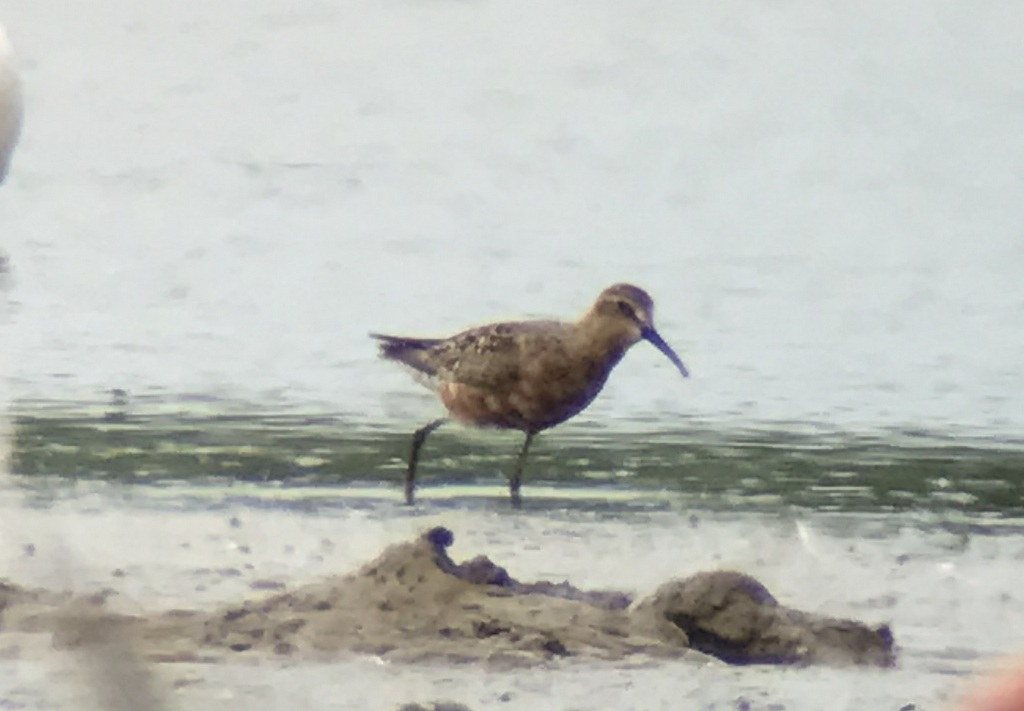
There were lots of Avocets on Pat’s Pool, which was liberally coated in them and Black-headed Gulls. The Avocets appear to have had a good breeding season and there were lots of juveniles in with them. One juvenile came down into the shallow water just in front of the hide, where we watched it sweeping its bill from side to side. We saw it catch a small fish, which it proceeded to wash in the water for several seconds before finally swallowing it.
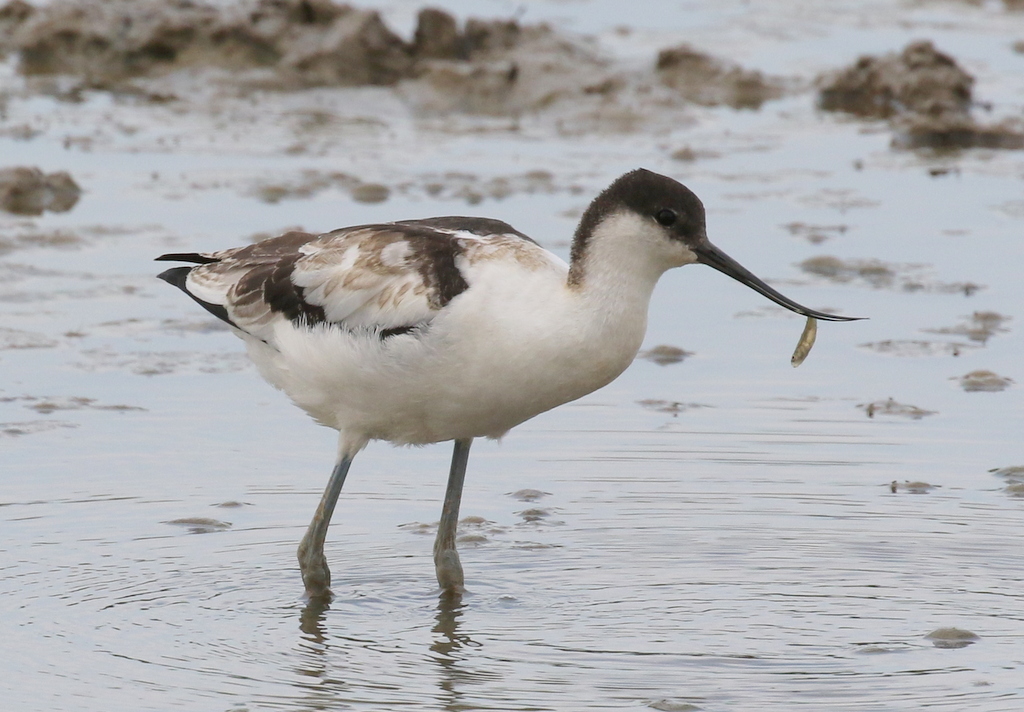
In amongst all the Black-headed Gulls out on the scrape, there were several Ruff too, returning males which have already moulted out their ornate ruff feathers. They are rather scruffy now and come in a huge variety of colours and patterns, a potential source of confusion. There were a few Lapwing too. The Black-tailed Godwits were mostly asleep on one of the islands, mostly adults still sporting their bright rusty breeding plumage.
We spotted an adult Little Ringed Plover on the mud right over the back of the scrape and could just about make out its golden yellow eye ring through the scope. Then we looked back at the mud right in front of the hide and there were two juvenile Little Ringed Plovers there, perfectly camouflaged against the brown of the dried mud when they stood still.
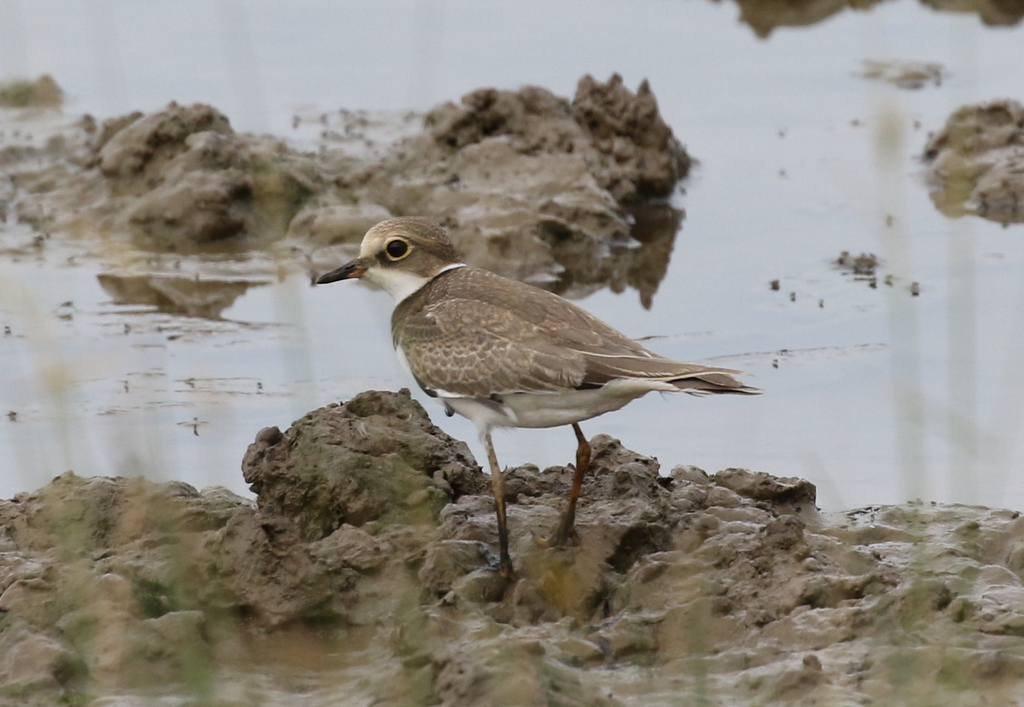
A juvenile Little Egret flew in and landed right in front of the hide too, still with grey-green legs and its dagger-like bill shorter than fully grown. There were several young Shoveler sleeping with the Mallard and Gadwall on the bank below the hide, and a Coot feeding a well grown juvenile here too. A Stoat running along the bank, in and out of the long grass, was only visible from one end of the hide though.
There was a Green Sandpiper feeding just beyond the bank, but it was hidden behind the vegetation at first. Thankfully it walked back towards us and moved out into the open mud, where we could get a good look at it, noting the differences from Common Sandpiper, particularly the lack of the white notch between the breast and the wings, as well as its slightly larger size.
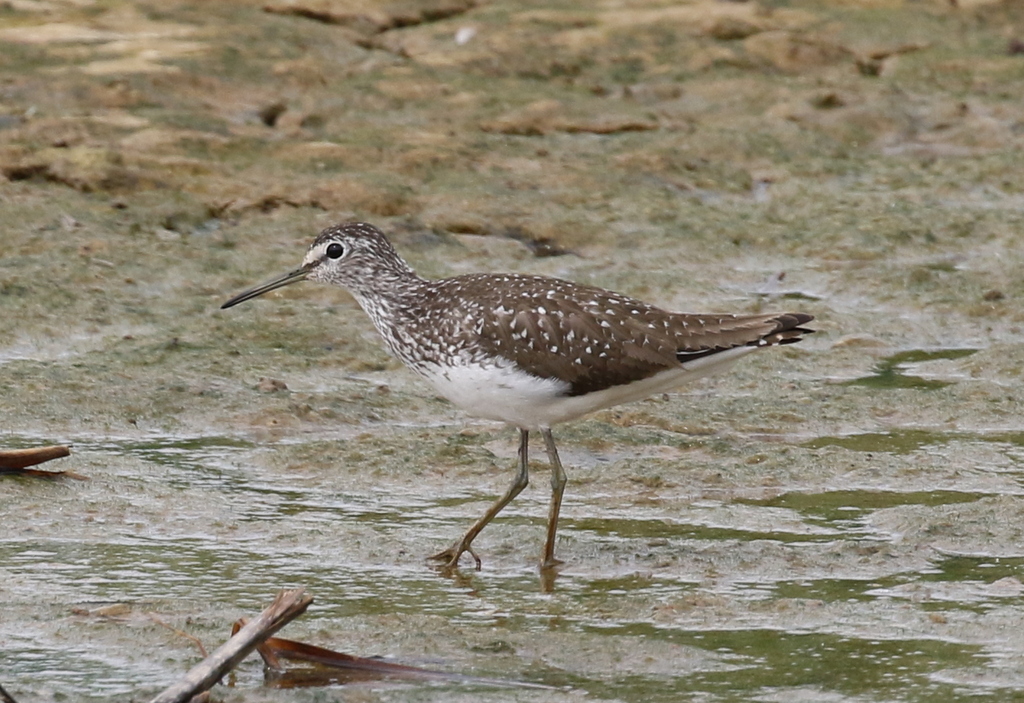
Eventually, we decided to tear ourselves away from all the activity here and walk out to the other hides out in the middle. A couple of Reed Warblers were feeding in the reeds along the other side of the ditch beside the path. Several House Martins were hawking for insects overhead. A smart Red Admiral butterfly was basking on the boardwalk, along with a Ruddy Darter dragonfly.
When we got out to Dauke’s Hide, the first thing we noticed were the Spoonbills. There were three of them here, two juveniles with still only partly grown bills, ‘teaspoons’, and one adult. One of the young ones was awake and preening allowing us to get a good look at it through the scope.
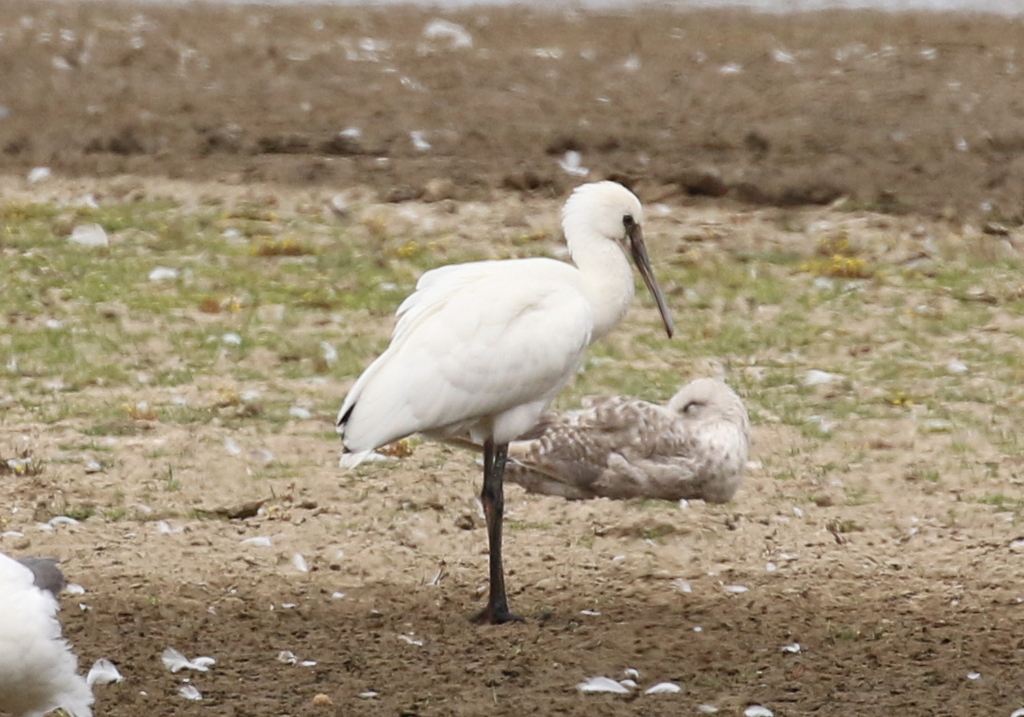
There were more waders on here, particularly Ruff and Black-tailed Godwits. Scanning through a group of the latter which were feeding out to the left of the hide, we could see one bird with a mass of colour rings on its legs. The yellow flag was carrying a geolocator and a lime-green ring marked with a black ‘E’ signalled it out as a bird from the small breeding population on the Nene Washes. These are Continental Black-tailed Godwits, of the nominate subspecies limosa, rather than the Icelandic race which comprise the vast bulk of the Black-tailed Godwits we see here.
In amongst the Icelandic Black-tailed Godwits further out was a single Knot, also still in its rusty breeding plumage. Eleven Dunlin were feeding out towards the back and a Common Snipe appeared on the edge of the reeds right at the rear of the scrape. Another Green Sandpiper dropped in on the margin of one of the islands briefly and two more juvenile Little Ringed Plovers were hard to see, feeding on the narrow strip of mud just beyond the bank in front of the hide. It looks like they have had a productive breeding season here too.
On one of the islands, about twenty large gulls were mostly asleep. The majority of them were slaty-backed Lesser Black-backed Gulls but amongst the paler-mantled Herring Gulls two had noticeably but slightly darker grey upperparts. When they finally awoke and stood up, we could see they had yellow legs too, different from the pink-legged Herring Gulls. They were Yellow-legged Gulls from continental Europe, an increasingly common late summer visitor here.
One of the paler backed gulls woke up too, and stood up. It looked rather unlike a Herring Gull, with a long sloping face and long parallel-sided bill. It had a darkish eye too. When it finally turned round we could confirm it was a Caspian Gull, an immature, in its third calendar year, with faded grey brown feathers in its wing and dark black-based tertials. This is a rarer but increasingly regular visitor here so a nice bird to find.
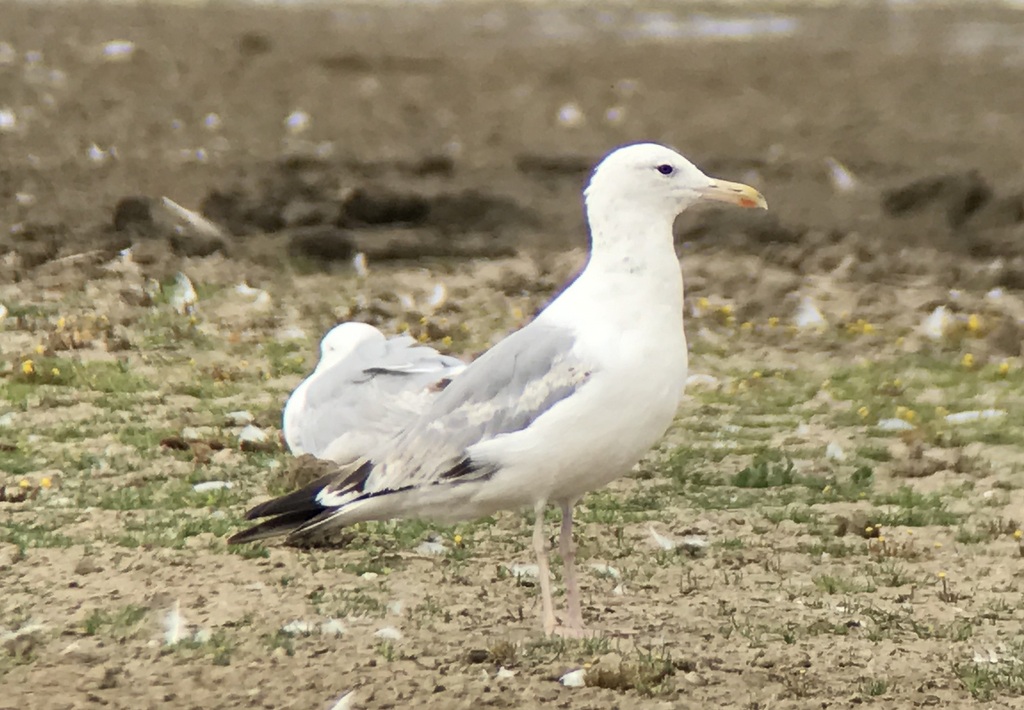
Back at the car, we drove the short distance along to the East Bank, although the car park was full and we had to park at Walsey Hills. We could hear a Cetti’s Warbler calling in the reeds and a Blackcap appeared in the bushes. An adult and two juvenile Little Grebes were out on Snipe’s Marsh. As we set off up the East Bank, several Common Pochard were in with the Mallards on Don’s Pool.
The grazing marsh here is mostly dried out now, but there is still water in the Serpentine. We could see a few people gathered further up along the bank, by the north end, so we continued on to join them. They were watching the Temminck’s Stint which had been found here earlier in the day and it soon emerged from behind the grass and started feeding on the edge of the mud.
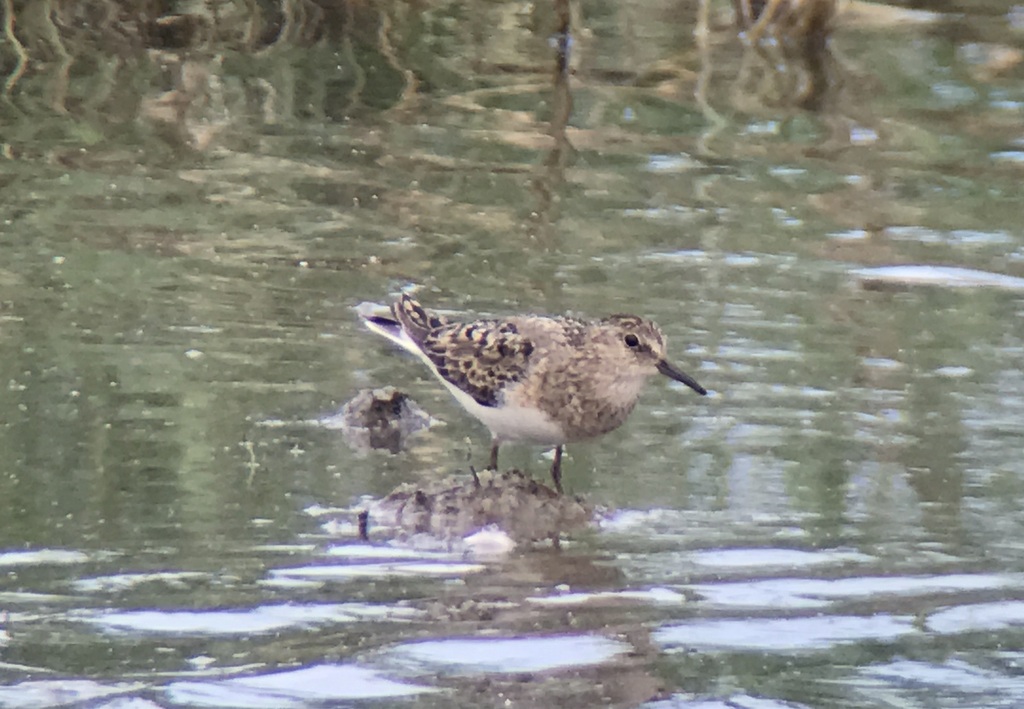
The Temminck’s Stint was creeping around on the mud in typical fashion. Through the scope, we could see its pale yellowish legs and the distinctive pattern of black-centred feathers in its upperparts. A Lapwing walked along the edge towards it and pushed the Temminck’s Stint off ahead of it. Next to the Lapwing, we could really see just how small it was.
When we heard Bearded Tits calling behind us, we turned round to see one flying fast just over the tops of the reeds, before crashing back in out of view, in typical fashion. We walked further up, and heard and glimpsed one or two more, before one flew in towards us and landed briefly in full view for a couple of seconds before it disappeared in.
There were two juvenile Marsh Harriers perched up in the bushes out in the middle of the reeds and we got one in the scope. It was plain, dark chocolate brown with a contrasting golden-orangey head. A little further along, a Sedge Warbler flew past us.
Out at Arnold’s Marsh, we stopped in the shelter for a scan. There were a few Sandwich Terns on one of the small gravel islands and a Ringed Plover popped up briefly on the edge of the saltmarsh in front of them. A small group of Dunlin was feeding out towards the back and there were several Redshank and Curlew out here too. Two Oystercatchers flew in, calling noisily, and landed on the saltmarsh towards the front.
A lone Brent Goose on the saltmarsh is most likely a sick or injured bird which was unable to make the journey back to Russia for the breeding season and has spent the summer here. There were several Cormorants drying their wings here and a young Great Black-backed Gull too. You cannot come all the way out here without at least looking at the sea, so we carried on out to the beach. A couple of Meadow Pipits flew up from the shingle ahead of us.
Looking out to sea, it all looked rather quiet at first. A few Sandwich Terns flew back and forth. Then a distant group of dark ducks were Common Scoter, probably birds just returning from Scandinavia for the winter and heading in towards the Wash. Five Curlew flew in towards us over the sea too, before turning west, again most likely migrants on their way here, fresh arrivals just coming back from the continent for the winter.
It had been a really good day, despite the heat, but it was now time to walk back to the car and head for home. More again tomorrow!
















